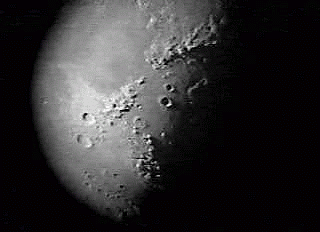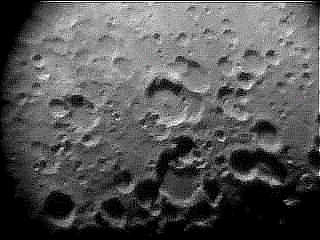Craters - 7 Days...
Piccolomini:
Date: December 22, 2002
Telescope: 4.5 Celestron reflector
Eyepiece: 10mm Celestron SMA
Time: (precise time not listed. reports indicate an early a.m. viewing time.)
I move on to the beautiful area of Mare Nectaris and delight in the craters of Theophilus, Fraucastorius, and Madler... But if there were one spot that I would wish to show you?
This would be it...
It is Crater Piccolomini. (yes, i know there's a noise line in my temporary shot. you know what? i don't care.) I chose this crater for my study point because it was just "the one" at the moment.
At about 56 miles in diameter, Piccolomini has a great set of mountains inside of it that tower up approximately 11,800 feet. It is wonderfully stepped, with those walls rising up at about 5,600 feet. The Altai Scarp cuts a brilliant presentation nearby, while Craters Rothman, Zagut and Lindenau share the field. The tiny craters that surround it are unnamed, except for numbers...
But they are grand.
Theophilus, Cyrillus and Catherina:
Date: September 16, 2003
Telesceope: 4.5 Celestron
Eyepieces: 25mm Celestron, 10mm Celestron
Time: (no specific time listed. notes indicate very early a.m.)
Comments: In this photo there are three prominent craters to the left that ring together. These are (from top to bottom) Catherina, Cyrillus, and Theophilus. Congratulations! You've learned some features...
Now let's dig deeper...

Now, looking a Cyrillus, there is a shallow crater just to the right of it... That's Ibn Rushd. (i've been rushed? oh, save me... alright. we are. we've got 10 minutes left!) Dig it. Now, see that big mountain? That's Mon Penck. (pink? and rushed? hehehehe...) At the "top" of that is crater Kant. (can't? here we go again...) To the bottom of the mountain is crater Zollner. (and a whole lot more that are just numbers. Now! Look at that penisula like feature, the pear shaped dude in the middle of that is Hyapatia. All right! Now you're cookin'... Just off the tip of that feature and to the right of that is two shallow, overlapping rings. Got 'em? Now, here the fun part! Those are Sabine and Ritter. Right beside that to the left is a tiny dark marking... Dude? That's where Apollo 11 landed!!! Just above that, and I mean only a couple of pixels above that, is where Surveyor 5 scouted out the landing area. And just a pixel left is where Ranger 6 bit the dust on February 2, 1964. Now! If you see the bright ring just to the right of Sabine? That's Dionysius, form a right triangle with this pair to bottom and you got where Ranger 8 successfully landed! Had enough? Alrighty, then... Go to the upper right quarter of the frame and see where a line of three craters move from top to bottom curving toward the middle. See 'em?
Now... See that rille that runs right off of 'em in the picture? Swish... That's where Apollo 16 landed!
Posidonius:
Date: July 15, 2002
Telescope: 4.5 Celestron
Eyepieces: 25mm Celestron, 10mm Celestron
Time: (no specific time listed. reports indicate p.m. viewing)
Comments: Incredibly enough, we're displaying some "earthshine" tonight, and some of the finest craters on the block! Starting with an old favourite, Posidonius, I run the power up to explore this ancient crater. Its' 3000 feet tall walls are soft, and eroded in appearance with one edge holding the pock marks of more recent craters. The entire 52 by 61 mile expanse appears shallow, but actually contains a great amount of detail. At modest magnification the 8500 ft. high central mountain peak is easy enough... But don't stop there, please. On a steady night, upping the power reveals wonderfully broken and stepped walls. Deep fissures that crease the stone-like floor... An intense central crater... And when things hold steady... The brightenings of other small craters and interior peaks. Posidonius is a fine place to visit... Remember?
Walking back the power a bit reveals the bulging vein of the Serpentine Ridge stretching itself from the orafice of Luther, past the well of Bessel, and upward toward the Archerusia Promentorium. The entire edge toward Posidonius aches with detail... Fathomless Daniel, rugged Chacornac, the circlet of Lemonnier, tiny Littrow, bright peak of Mt. Argaeus and the diminuative Dawes. Hey, Selene? You rock!

Crater Posidonius and surrounds.
Fracaustorius:
Date: July 27, 2002
Telescope: 4.5 Celestron
Eyepiece: 25mm Celestron
Time: (no specific time listed. reports indicate late p.m.)
Comments: Next for me is the ancient cup of Fracastorius... as eroded and dusty as a horseshoe print in sand. Picollomini I recognize instantly with its' standout cental peak and stepped walls. Metius and Fabricius are also old companions, and I think Janssen is perhaps the finest I've seen it.
Aristoteles:
Date: February 18, 2002
Telescope: 4.5 Celestron
Eyepiece: 25mm Celestron
Time: (no specific time listed. reports indicate late p.m.)
Comments: The Moon came next.... And there I froze. Wow! Where do I start? The double punctures of Aristoteles and Eudoxus? The shallow forms of Theophilus and Cyrillus? How about the little hole Arago? Holy Moonbeam! They're all beautiful...
Eudoxus:
Date: October 13, 2002
Telescope: 4.5 Celestron
Eyepieces: 25mm Celestron, 10mm Celestron
Time: (no specific time listed. reports indicate late p.m.)
Comments: Aristotle and Eudoxus were simply amazing. Their interior ridges and multiple peaks supported everything I had to throw at it. Tiny craters leaped to life... Ones with obscure names like Kane, Mitchell, Edege, and Sheepshank. (all right, who tied the knot on the moon?) A and B craters identified on the maps kept their hard-edged quality. The Appennine, Caucasus, and Haemus Mountain ranges reflected the light in such a way that they appeared like snow covered peaks seen on a relief map. This is just too awesome!

Aristotle and Eudoxus are the well lighted large craters, with the Caucasus Mountians extending above them with tiny crater Callipus featured.
Cassini:
Date: June 17, 2002
Telescope: 4.5 Celestron
Eyepiece: 25mm Celestron
Time: (no specific time listed. reports indicate late p.m.)
Cassini: Comments: Well, you can see where my attention was drawn, can't you? When I see that deep scar of the Alpine Valley cutting across the lunar landscape, I am lost. Exploring its' 110 mile length and 1 to 13 mile width at every range of magnification I can throw at it! Tempting little Cassini with it's multi-lipped interior and grand Aristillus and Aurolycus... and to climb the rugged peak of 15,000 feet high Mons Hadley. How restful the expanse of Mare Serenitatis is...
Hipparchus and Albategnius:
Date: December 1, 2003
Telescope: 4.5 Celestron
Eyepieces: 25mm Celestron, 10mm Celestron
Time: (no specific time listed. reports indicate late p.m.)
Comments: Albategnius simply rocks tonight. The combination of minute craters around it's edges along with the soft indentations and central peak makes it a truly fine place to stop and study for awhile. Along the edges of its' rugged structure, craters Klein and Halley just add more interest. Albategnius has more than just tonight's claim to fame however... For it as the first lunar object to be lighted by an Earth based laser in 1962. Nearby Hipparchus also offers a wealth of opportunities with all of its' small lettered craters.

Crater Hipparchus is front and center on the terminator while Albategnius appears to its' right.
Aristillus:
Date: March 10, 2003
Telescope: 150mm Intes
Eyepiece: 32mm Celestron
Time: (no specific time listed. reports indicate late p.m.)
Comments: First thing that caught my eye and kept it was the deep scar of the Alpine Valley. The Appenine and Caucasus Mountains were just outstanding in the light! Prominent Craters Aristillus and Autolycus danced in the rille ridden cove of the partially disclosed Mare Ibrium. Even the ruined walls of Cassini were cooperating! Mons Hadley, Paulus Putredinus, tiny Theaetetus, Agasiz Promentorium, Deville Promentorium... Even Piton played a part tonight!
Autolycus:
Date: March 20, 2002
Telescope: 4.5 Celestron
Eyepieces: 25mm Celestron, 10mm Celestron
Time: (no specific time listed. reports indicate late p.m.)
Comments: Yeah, the sky was unstable. It pitched, it rolled, it waivered... It was GREAT! Exploring the depths of Hipparchus and Albategnius... Dancing around Aristillus and Autolycus... Rounding the edges of Cassini and climbing the Apennine Mountains! And just where did I want to be most of all? (Besides apparently fascinated by that strange flat feature between Manilus and Julius Ceasar... ;) Why, the Apollo 11 landing site, of course! (and you knew that was coming, didn't you? ;)

A portion of Mare Serenitatis is visble to the upper left of the Caucasus and Appennine Mountain ranges. Aristillus and Autolycus are almost center in this frame and show as two dark orafices.
Maurolycus:
Date: July 30, 2002
Telescope: 4.5 Celestron
Eyepieces: 25mm Celestron, 10mm Celestron
Time: 2:00 a.m.
Comments: Around about 2:00 or so, I went back out and the bright silver of the Moon certainly called! Shall we have a look while the rest of these clouds push away? Then grab the 4.5 and let's go...
Maurolycus just walks right out the moment you look, but Theophilus, Cyrillus and Catharina are the ones to grab the attention! There's a tiny little crater lying between Theophilus and the terminator that just smiles away! Clever little fellow... I wonder what his name is?

Crater Stofler appears center on the terminator, while Maurolycus and its' many features is just above.
|